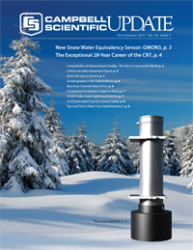
During the past year, I have spent some time chairing the Organization/Business Models Working Group of the American Meteorological Society (AMS) ad hoc committee on the Nationwide Network of Networks (NNoN). One of the objectives of the ad hoc committee's work is to broaden the availability and use of mesoscale observations. As one contemplates this eventuality, the issues relating to measurement quality are immediately placed front and center.
When we hear the term "network" applied to multiple stations that have been deployed to measure environmental conditions, an important implication is that measurements at each station are made in a way to be comparable with similar measurements at other stations. If the accuracy of a given measurement has been assessed at one site, then it is preferred if like measurements at all sites within a network can be trusted to the same extent. Likewise, this would extend to similar parametric measurements across network boundaries if data from more than one network are combined for use in the same model or report. Another important implication is that time stamps from different dataloggers across the network are sufficiently synchronous for meaningful spatial data association.
The key to combining two or more mesoscale networks into a larger (virtual) network is compatibility of measurement quality. A network of networks at any scale is only achievable with the adoption of suitable metadata standards and the qualification of reasonably comparable data that is being consolidated. In the case of a NNoN, the AMS ad hoc committee is proposing the adoption of ISO Standard 19115-2 and SensorML, which standards are adequate to identify measurements with specifications, calibration, and maintenance information, even allowing for specific information pertaining to individual observations when necessary.
The operator of a network desiring to make observations available to other networks would make metadata available that allow potential users of the data to judge both temporal and spatial comparability. Users must be able to discover relevant observations, qualify their sources through the metadata, and ultimately perform reasonable quality control.
Data discovery, assessment of suitability, data exchange, and quality control of observations constitute process functions of the data recipient. A measurement network operator or provider must generate and maintain metadata, make the observations, and serve the data to the recipient. For the economic proposition of a NNoN to make sense, the cost of adopting and maintaining standards, data discovery, qualification, and exchange must be less than the cost of creating or expanding a uni-purpose measurement network. The cost of quality control might be the same with or without consolidation, with pros and cons that could be argued. The ultimate significance of a NNoN will be judged by the success of data exchange and satisfaction of data use by recipients.
It is likely that there will be reasonable economic benefits to a NNoN, especially to maximize the availability of high-cost observations to satisfy multiple uses. For routine observations that are low cost and easy to make, the appeal of a virtual network might be less, but even single-purpose measurement networks can benefit from vigilance in making quality measurements, maintaining metadata, and exercising reasonable quality control.
Campbell Scientific will continue to offer high-quality measurement systems able to satisfy the needs of individual environmental measurement networks with a view to accommodate the exchange of data between networks.

